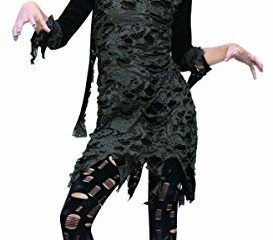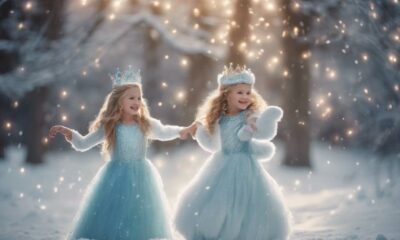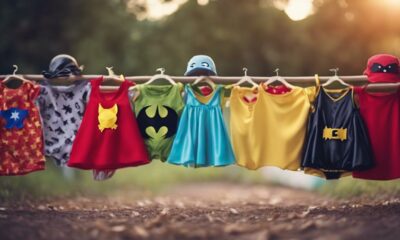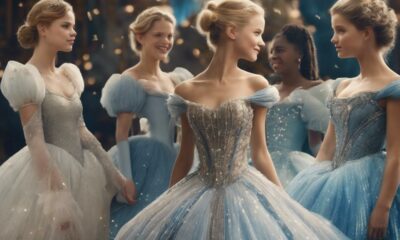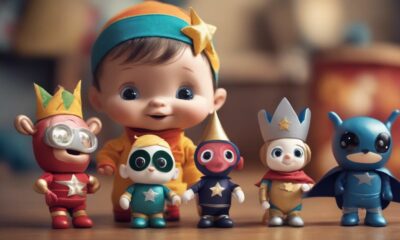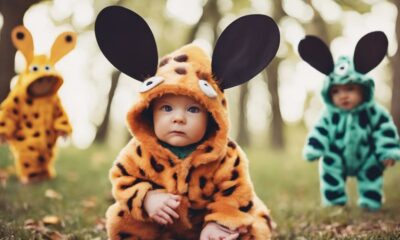Halloween
Does Costa Rica Celebrate Halloween
Yearning to uncover the unique blend of cultural traditions, discover how Costa Rica celebrates Halloween with a twist on el día de la mascarada.
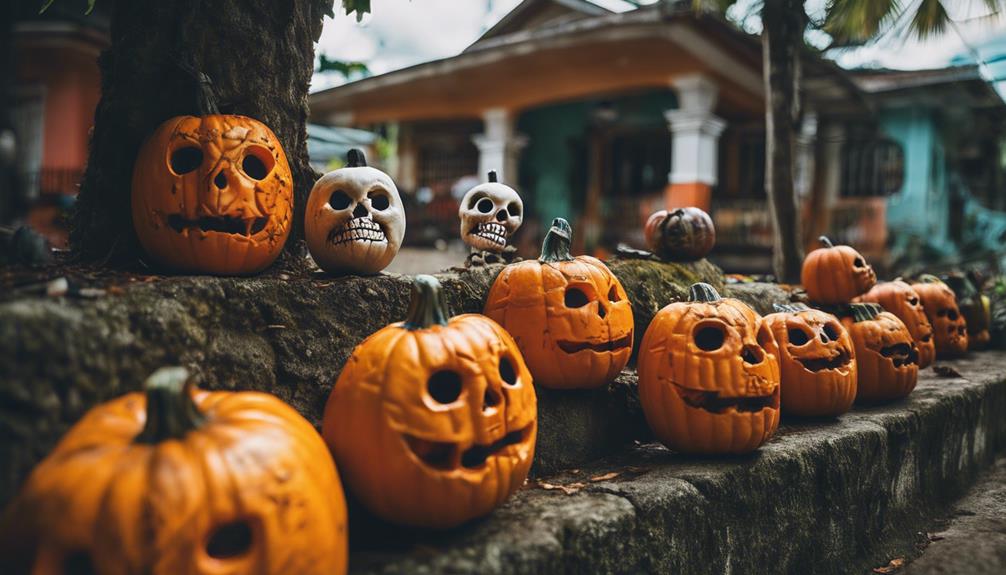
Costa Rica uniquely celebrates Halloween as el día de la mascarada on October 31st, showcasing traditional customs. This day honors the country's cultural heritage and indigenous roots through elaborate handmade paper mache masks depicting animals, historical figures, and giant masks from pre-Colombian traditions. Festivities include lively cimarron music bands and colorful parades, blending Catholic influence with indigenous beliefs. These vibrant celebrations reflect Costa Rica's rich heritage, engaging both locals and tourists. Discover more about this fascinating blend of traditions that make Costa Rican Halloween a truly special experience.
Key Takeaways
- Costa Rica celebrates el día de la mascarada on October 31st.
- The celebration honors cultural heritage and indigenous roots.
- It features handmade paper mache masks depicting animals and historical figures.
- The tradition includes giant masks from pre-Colombian customs.
- Cimarron music bands provide lively rhythms during the festivities.
Costa Rican Halloween Traditions
Costa Ricans celebrate el día de la mascarada on October 31st as a vibrant tradition preceding All Saints Day. This celebration in Costa Rica honors the country's cultural heritage and indigenous roots through colorful festivities.
The event features traditional masquerades with participants wearing handmade paper mache masks. These masks often depict animals, mythical creatures, and historical figures, showcasing the rich history of the country. The masquerade parade includes giant masks that trace back to pre-Colombian customs, adding a unique touch to the Halloween celebration.
To enhance the festive atmosphere, cimarron music bands accompany the procession, filling the air with lively rhythms. The significance of these masks lies in their representation of local legends, animals, and historical figures, making the celebration not only visually stunning but also deeply rooted in Costa Rican culture.
Masquerade Day Origins in Costa Rica
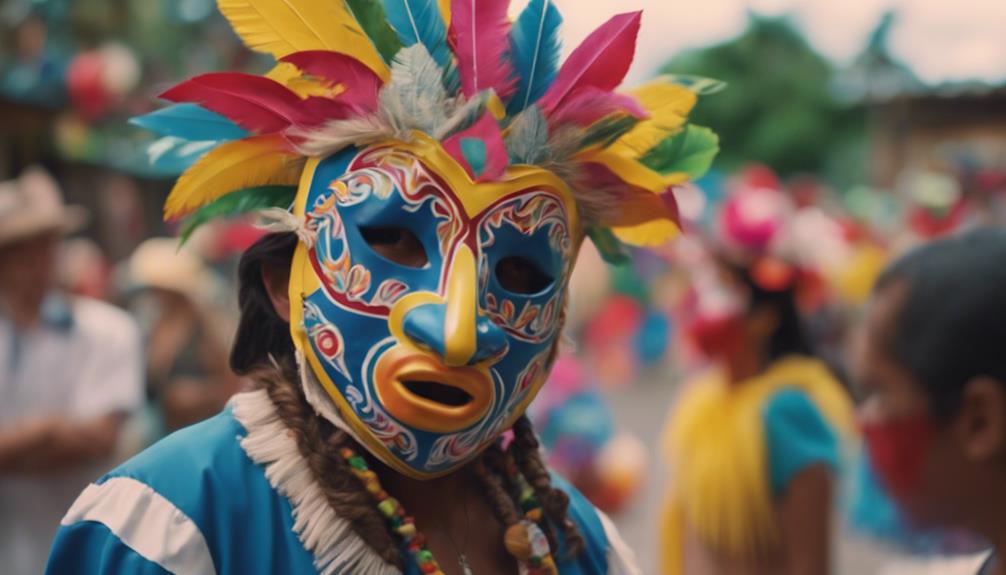
Originating from a tradition introduced during the Spanish colonial period, Masquerade Day in Costa Rica has evolved into a vibrant celebration that combines ancient customs with modern influences.
The first Masquerade Day in Costa Rica dates back to 1824, dedicated to honoring the Patroness of Costa Rica. This celebration intertwines the rich pre-Colombian customs with contemporary elements, creating a unique cultural expression.
In 1996, the tradition of Masquerade Day was officially declared as the National Day of Masquerade in Costa Rica, emphasizing its importance in the country's heritage.
During Masquerade Day, colorful parades featuring giant masks take center stage, showcasing the cultural richness and diversity of Costa Rica. This festive occasion not only highlights the artistic talents of the Costa Rican people but also serves as a reminder of the country's historical roots and the continuous evolution of its traditions.
Masquerade Day stands as a proof to Costa Rica's ability to preserve its heritage while embracing modern influences.
Mythical Masks of Costa Rica
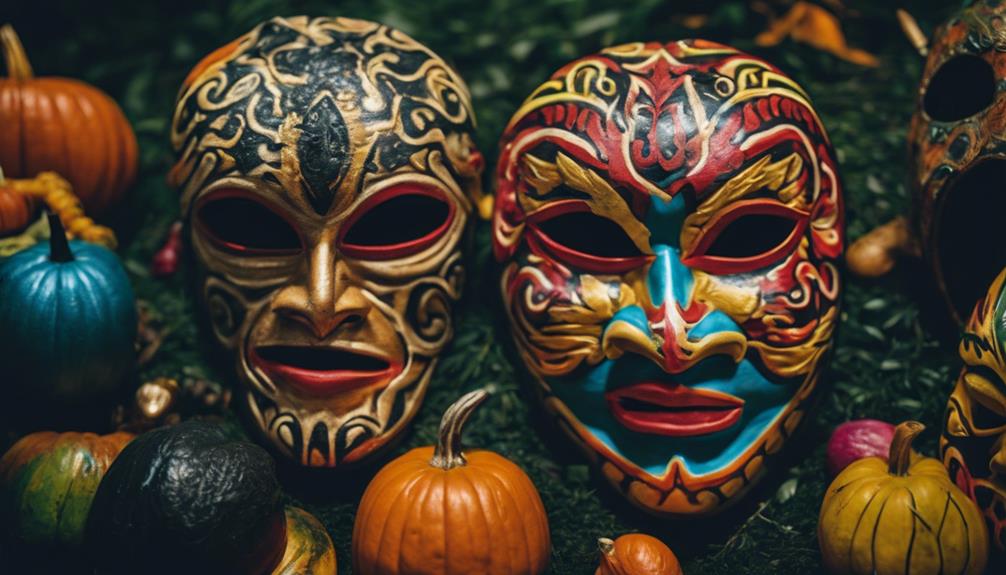
Mythical masks in Costa Rica are intricate, handcrafted creations that depict animals and mythical creatures. Crafted using the paper mache technique, these masks feature vibrant colors and detailed designs.
Symbolizing nature, history, and cultural heritage, these masks are a tribute to Costa Rica's rich traditions and the artistry of its local artisans.
Traditional Mask Designs
Artisans in Costa Rica intricately craft vibrant masks that depict animals, mythical creatures, and historical figures, showcasing the country's rich cultural heritage. These Costa Rican masks are traditional, handmade using the paper mache technique and adorned with vibrant colors. Reflecting the indigenous roots of Costa Rica, these masks hold significant cultural value.
Skilled artisans dedicate themselves to preserving stories and traditions through the intricate designs of these masks. During Masquerade Day, the masks worn celebrate the connection between humans and nature, embodying the essence of Costa Rica's cultural pride. Through these masks, Costa Rica highlights its diverse traditions and continues to honor its heritage with every meticulously crafted piece.
Cultural Significance
In Costa Rica, the cultural significance of mythical masks lies in their intricate designs and vibrant colors that symbolize the country's diverse traditions and rich heritage. These giant, handmade creations, depicting animals and mythical creatures using the paper mache technique, hold symbolic representations of nature, history, and cultural heritage, reflecting the diverse traditions of Costa Rica.
Crafted with intricate designs and vibrant colors, these masks tell stories, preserve culture, and showcase the country's traditional artistry. Mask making is a significant part of Costa Rican culture, highlighting indigenous roots and celebrating shared identity through the art of mask creation.
Cultural Significance of Masks

Costa Rican masks hold deep cultural significance, crafted using traditional techniques and adorned with vibrant paints and feathers. These masks symbolize animals, mythical creatures, and historical figures, showcasing the country's diverse traditions and cultural pride.
Through intricate designs and colorful displays, local artisans bring mystery and enchantment to Masquerade Day celebrations, highlighting the connection between humans and nature, folklore, legends, and the rich cultural heritage of Costa Rica.
Traditional Mask-Making Techniques
Traditional mask-making techniques in Costa Rica showcase the intricate artistry and cultural richness through the use of paper mache.
- Artisans in Costa Rica employ handcrafted techniques to create masks that represent a wide array of animals, mythical creatures, and historical figures.
- The process of making these masks reflects the deep-rooted cultural traditions of Costa Rica, highlighting the country's heritage and artistic expression.
- Through their creativity and skill, local artisans infuse each mask with intricate details and vibrant colors, making them truly enchanting pieces of art.
- These masks play a significant role in celebrations, adding an element of mystery and enchantment that mesmerizes both participants and spectators.
Symbolism in Mask Designs
Showcasing a blend of nature, history, and indigenous roots, the symbolism found in Costa Rican mask designs embodies a rich tapestry of cultural significance. These masks symbolize a variety of animals, mythical creatures, and historical figures, reflecting the country's diverse cultural traditions.
Handcrafted with intricate designs and vibrant colors, Costa Rican masks not only showcase artistic expression but also highlight the nation's deep connection to nature and conservation efforts. Local artisans demonstrate exceptional creativity and craftsmanship in the intricate process of mask making, preserving traditional techniques passed down through generations.
Masks worn during Masquerade Day serve as a powerful representation of Costa Rica's cultural identity, emphasizing the importance of conservation and folklore in the country's heritage.
Vibrant Halloween Festivities in Costa Rica

Colorful costumes and giant masks fill the streets of Costa Rica on October 31st during the vibrant Halloween festivities known as el día de la mascarada. This celebration blends pre-Colombian traditions with modern Halloween revelry, showcasing Costa Rica's rich cultural heritage.
Here are some highlights of the vibrant Halloween festivities in Costa Rica:
- Blend of Traditions: El día de la mascarada in Costa Rica reflects a unique fusion of Catholic influence and indigenous beliefs, creating a colorful and dynamic celebration.
- Giant Masks: The streets come alive with giant masks, a symbol of Costa Rican folklore and history, adding a touch of mystique to the vibrant parade.
- Costumed Puppets: Giant costumed puppets representing traditional Costa Rican folk characters march through the streets, captivating spectators with their elaborate designs and storytelling.
- Colorful Parade: The masquerade day parade is a sight to behold, with locals and tourists alike joining in the festivities, adding to the vibrant atmosphere of the celebration.
The Art of Mask Making
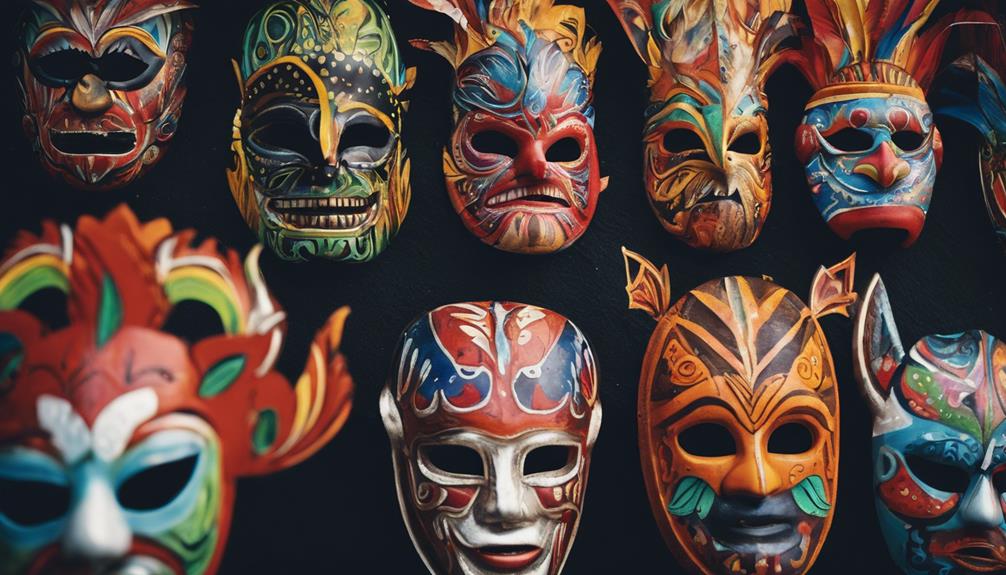
Local artisans in Costa Rica skillfully craft intricate handmade paper mache masks adorned with vibrant colors and feathers, symbolizing animals, mythical creatures, and historical figures. These masks are deeply rooted in Costa Rica's cultural traditions, reflecting the creativity and heritage of the artisans who meticulously create them. The process of mask making is not merely a craft but a form of art that captures the essence of mystery and enchantment, adding a touch of intrigue to Masquerade Day celebrations. The vibrant colors and elaborate designs evoke a sense of wonder, drawing both participants and spectators into the rich tapestry of Costa Rican traditions. Through the art of mask making, artisans pay homage to the country's indigenous roots, preserving ancient techniques and storytelling through their masterful creations.
| Costa Rica Mask Making | |
|---|---|
| Key Aspects | Description |
| Handmade | Artisans craft masks by hand |
| Paper Mache | Masks are made using paper mache technique |
| Vibrant Colors | Masks are adorned with bright and lively hues |
Symbolism in Costa Rican Masks

Symbolic representations embedded in Costa Rican masks reflect the intricate tapestry of the country's cultural heritage and storytelling traditions.
- The handmade Costa Rican masks crafted using the paper mache technique are adorned with vibrant colors that catch the eye and intricate designs that tell stories of the past.
- These masks symbolize various entities such as animals, mythical creatures, and historical figures, offering a glimpse into Costa Rica's rich cultural heritage and indigenous roots.
- Local artisans pour their creativity and expertise into the meticulous process of mask making, showcasing their dedication to preserving traditional art forms.
- The symbolism in these masks goes beyond aesthetics; they serve as a reminder of the deep connection between humans and nature, advocating for conservation efforts and highlighting the cultural significance of wildlife in Costa Rica.
Embracing Costa Rican Heritage

Embracing its rich cultural heritage, Costa Rica celebrates el día de la mascarada on October 31, a tradition deeply rooted in pre-Colombian customs. This vibrant event features a colorful parade where participants don giant masks, harkening back to ancient traditions and reflecting Costa Rica's historical significance.
Cimarron music bands provide lively tunes, adding to the festive atmosphere that permeates the celebration. Handmade masks crafted from paper mache are a focal point of the masquerade, depicting a variety of animals, mythical creatures, and historical figures. These masks not only showcase the country's artistic traditions but also serve as a link to its past, dating back to the pre-Columbian era.
Through el día de la mascarada, Costa Ricans come together in a multigenerational celebration that honors their cultural roots and strengthens the sense of community. This annual event is a demonstration of the enduring traditions that shape Costa Rican identity and unite its people in a shared heritage.
Best Time to Experience Costa Rican Halloween

Exploring the vibrant celebrations of Masquerade Day in Costa Rica offers a unique opportunity to immerse oneself in the colorful blend of Halloween excitement and traditional Costa Rican customs. The best time to experience Costa Rican Halloween is on October 31st, during Masquerade Day. Here's why:
- Cultural Twist: Costa Rica puts a unique spin on Halloween with Masquerade Day, showcasing its rich heritage through elaborate masks and traditional dances.
- Giant Masks: Witness colorful parades featuring giant masks that pay homage to animals, mythical creatures, and historical figures, adding a touch of whimsical charm to the festivities.
- Traditional Dances & Music: Enjoy the rhythmic beats and lively tunes that fill the air during Masquerade Day, as locals perform traditional dances that reflect the country's vibrant culture.
- Costa Rican Heritage: Immerse yourself in the essence of Costa Rica by witnessing skilled artisans create intricate masks in cities like Cartago, Escazu, and Barva de Heredia, highlighting the country's artistic talent and cultural pride.
Frequently Asked Questions
How Do They Celebrate Halloween in Costa Rica?
Costa Ricans celebrate Halloween with parades, costume parties, and trick-or-treating for candy. The country infuses spooky legends like CADEJOS and LA SEGUA into its celebrations. Ghost stories, such as La Llorona, and haunted locations like Cartago enhance the mysterious atmosphere.
Supernatural beings like duendes are believed to inhabit rainforests in Arenal and Monteverde during Halloween. This unique blend of Catholic and indigenous influences creates a distinctive cultural fusion during the holiday.
What Does Costa Rica Celebrate in October?
In October, Costa Rica celebrates 'El día de la mascarada,' a vibrant tradition featuring a lively parade with oversized masks. This event, rooted in pre-Colombian customs, showcases cimarron music bands and pays homage to Costa Rican cultural heritage.
Handcrafted paper mache masks in vivid hues depict animals, mythical beings, and historical figures. The government officially recognized October 31 as the Day of Traditional Costa Rican Masquerade in 1996, making it a cherished multigenerational family affair.
What Holiday Do Costa Ricans Celebrate?
Costa Ricans celebrate el día de la mascarada, a traditional holiday on October 31st. The celebration precedes All Saints Day, showcasing culture and heritage with a colorful parade featuring giant masks from pre-Colombian customs.
Accompanied by cimarron music bands, this event is a multigenerational family affair. Masquerade Day in Costa Rica promotes cultural knowledge and identity, dating back to the pre-Columbian era.
Does Costa Rica Have Any Traditions?
Costa Rica has rich cultural traditions.
One popular celebration is el día de la mascarada, which takes place on October 31st. The event features a vibrant parade with giant masks, rooted in pre-Colombian customs.
Families gather to enjoy the festivities, accompanied by cimarron music bands. These bands, comprised of self-taught musicians, play traditional tunes, promoting cultural knowledge and celebrating the country's heritage.
Costa Rica's traditions are diverse and deeply meaningful to its people.
Conclusion
To sum up, Costa Rica's unique Halloween traditions, such as Masquerade Day and the art of mask making, offer a vibrant celebration of culture and heritage.
The colorful masks and festivities symbolize the rich history and folklore of the country, creating a mesmerizing experience for locals and visitors alike.
Embracing Costa Rican Halloween is a chance to immerse oneself in a world of mythical stories and artistic expression, making it a truly unforgettable experience.
Hi, I’m Absinthe. I help manage Halloween Product Reviews, the only website you’ll need for all your Halloween essentials. My favorite holiday is, undoubtedly, Halloween. I thrive on the spooky atmosphere, the creative costumes, and yes—the candy! I am always on the lookout for new and exciting ways to celebrate and share my discoveries to enhance your Halloween experience. Make sure to visit us, and I promise you’ll find something to make your Halloween unforgettable!
Halloween
The Impact of Halloween on Local Economies: Beyond Retail Sales
Halloween’s influence on local economies extends far beyond retail, creating lasting effects that will surprise you. Discover how communities thrive each October.
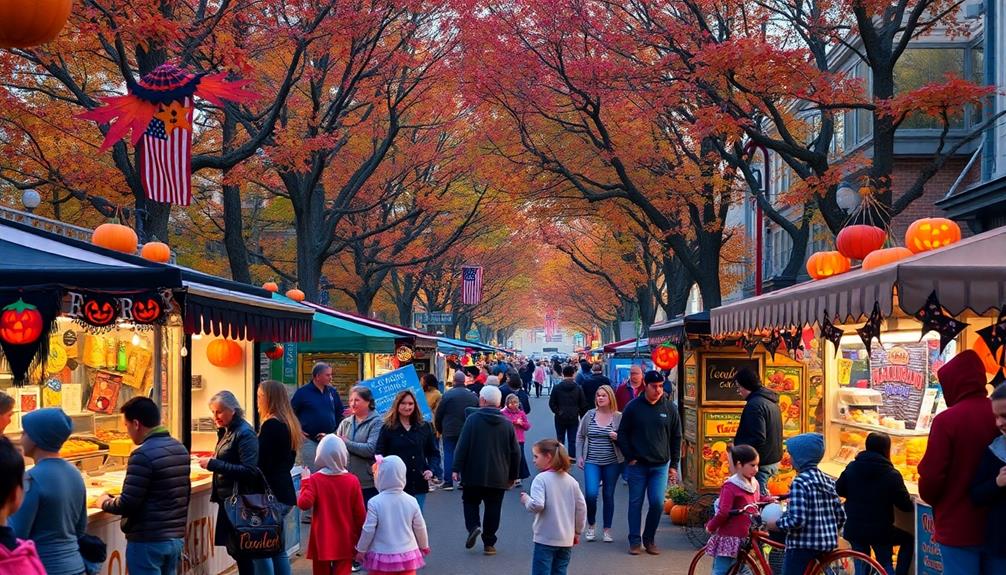
Halloween's impact on local economies goes far beyond retail sales. You'll see a boost in tourism revenue with many towns experiencing a 20-30% increase during October. Local events like festivals and parades create vibrant atmospheres, drawing in visitors and enhancing community spirit. Haunted attractions thrive, drawing millions and benefiting nearby businesses through increased foot traffic. Seasonal jobs also spike, offering opportunities for part-time workers. Plus, marketing strategies ramp up, fueled by consumer enthusiasm. The ripple effects of Halloween spending can even linger long after. There's plenty more to uncover about its lasting influence on communities.
Key Takeaways
- Halloween tourism boosts local economies, generating approximately $10 billion in annual consumer spending and increasing tourism revenue by 20-30% in October.
- Community events and festivals enhance local engagement, attracting thousands of visitors and fostering a sense of togetherness among residents.
- Seasonal job creation arises from increased demand, providing part-time opportunities that may lead to permanent employment in local businesses.
- Local businesses experience heightened sales, with costume shops reporting increases of up to 300% during the Halloween season.
- Halloween-related activities improve year-round tourism visibility, making local economies more resilient and stable in the long term.
Economic Impact of Halloween Tourism
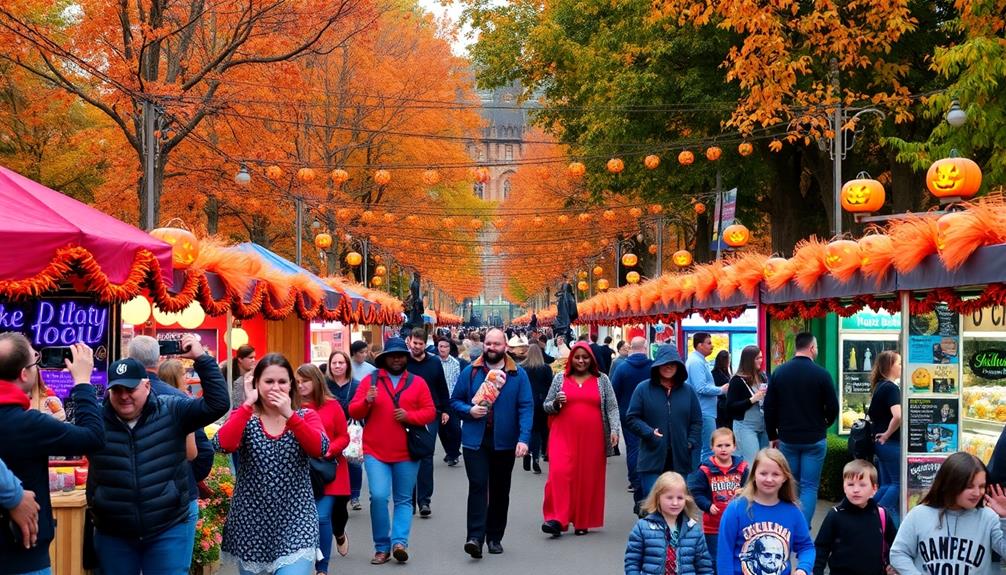
Economic Impact of Halloween Tourism
Every October, Halloween tourism creates a significant economic boost for local communities across the U.S. The holiday generates around $10 billion in consumer spending annually, which directly impacts the local economy. When you visit cities known for their Halloween events, you might notice a 20-30% increase in tourism revenue, especially benefiting local hotels and restaurants. This surge in visitors not only fills up accommodations but also keeps eateries bustling with activity.
In places like Australia, for instance, the growing popularity of Halloween has led to an increase in themed events and costume sales, contributing to local economic growth as well (Halloween Celebrations in Australia).
Haunted attractions draw millions each October, highlighting Halloween's critical role in driving tourism. As you enjoy these spooky experiences, you're contributing to a thriving local economy.
Additionally, media coverage of Halloween events gives host cities free publicity, enhancing their appeal as year-round tourist destinations. That means even after the holiday is over, businesses continue to reap the benefits of your interest in Halloween-related activities.
This sustained interest fosters ongoing economic growth, ensuring local businesses thrive well beyond the Halloween season. So, next time you participate in Halloween festivities, remember that you're not just having fun; you're playing a key role in supporting and elevating the local economy.
Seasonal Business Growth and Employment
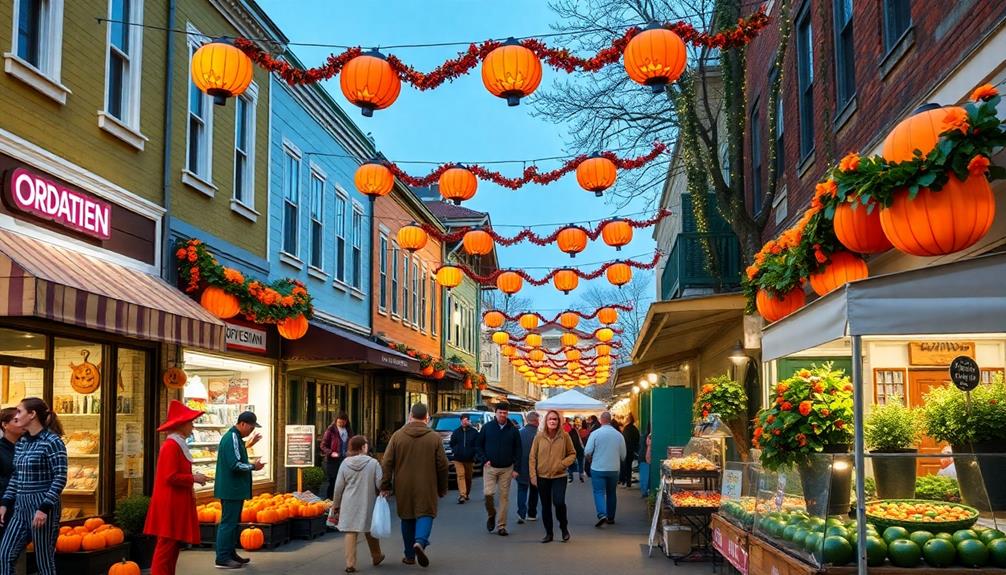
As Halloween approaches, you'll likely notice a dramatic increase in retail sales, especially in costume shops and party supply stores.
This seasonal boom creates numerous job opportunities, with many businesses hiring part-time workers to meet the demand.
Additionally, local events and parties often incorporate fun and games, such as swimming pool game ideas, which can further stimulate community engagement and spending.
The trends you see in your community not only boost local economies but also enhance the overall festive spirit.
Retail Sales Surge
Leading up to Halloween, retailers often see a remarkable spike in sales, transforming the holiday into a significant economic boost for local economies. This retail sales surge is evident as costume shops report increases of up to 300%, with overall Halloween-related sales rising by 15%.
As you engage in Halloween spending, you're contributing to the heightened demand for costumes, decorations, candy, and party supplies, which stimulates consumer spending across various sectors. Additionally, many restaurants and fast food chains adjust their operating hours to accommodate increased foot traffic during this festive time.
Online sales are also thriving, with an annual growth of over 20% for Halloween products, making it easy for you to find what you need from the comfort of your home. Seasonal businesses, like pop-up shops, are hiring part-time workers to meet this increased demand, enhancing job creation in your community. This influx of seasonal employment not only supports local workers but also boosts overall spending power.
Moreover, local artisans and crafters benefit from the surge in demand for handmade goods, adding to the overall retail growth during this festive season.
Job Creation Opportunities
The Halloween season opens up a wealth of job creation opportunities, especially in local communities. As costume shops, haunted attractions, and retail sectors ramp up hiring, you'll see a surge in seasonal employment. This increased demand for Halloween-related products and services drives economic activity, creating thousands of part-time jobs.
Additionally, businesses can benefit from strategic planning to maximize their seasonal revenue, similar to how investors can maximize IRA contributions.
- Costume shops may report sales increases of up to 300%, necessitating extra staff.
- Pop-up stores and haunted houses contribute notably to local economies, with regions like Arizona creating 4,000 to 5,000 temporary jobs during this festive period.
- The National Retail Federation predicts that 73% of consumers will celebrate Halloween in 2023, amplifying the need for seasonal positions that could lead to long-term employment.
These job creation opportunities not only provide valuable work experience but also enhance community spending power.
As more people find temporary employment, local businesses thrive, resulting in a positive ripple effect throughout the economy.
This Halloween, consider how the seasonal jobs you find can contribute to a more vibrant local economy while benefiting your financial situation.
Seasonal Employment Trends
Halloween's influence on seasonal employment trends is undeniable, with local businesses gearing up to meet the surge in demand. As 73% of consumers plan to celebrate Halloween in 2023, many retailers, particularly costume shops and haunted attractions, are ramping up their hiring efforts. This increase in spending translates to the creation of thousands of temporary jobs, addressing the heightened need for staff to manage the influx of customers.
Significantly, similar to how Louisiana alimony laws consider various factors for support, businesses assess their staffing needs based on projected sales and customer traffic during the Halloween season.
Retail sales during this season often spike dramatically, with some costume shops reporting sales increases of up to 300%. This boom prompts businesses to seek out additional part-time workers to help manage the economic activity.
E-commerce platforms are also feeling the impact, as online sales for Halloween-related products have grown over 20% annually, necessitating even more seasonal employment opportunities.
Additionally, local artisans and crafters benefit from this festive period, as demand for handmade goods rises. This trend not only fosters job creation but also stimulates economic activity within the community.
Community Engagement Through Events
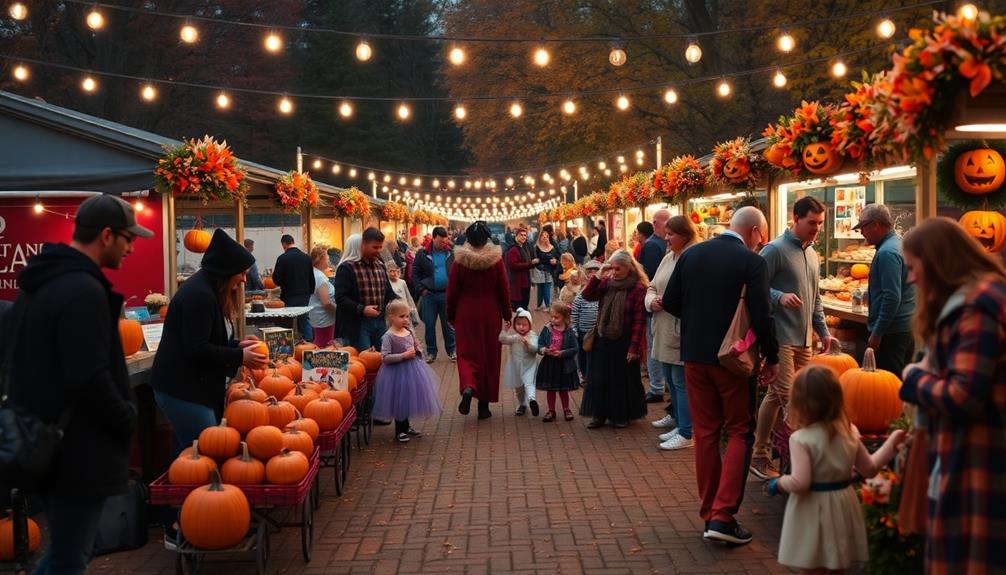
Halloween brings your community together through exciting festivals and parades that celebrate local spirit.
These events often encourage engaging guests with games and creative decorations, further enhancing the festive atmosphere.
You'll often see businesses stepping up to sponsor these events, helping raise funds for important charitable causes.
This vibrant participation not only boosts engagement but also strengthens the bonds among residents, creating a more connected neighborhood.
Local Festivals and Parades
Community festivals and parades during the Halloween season create vibrant opportunities for local engagement and economic stimulation. These local festivals not only foster community pride but also draw thousands of visitors, greatly boosting local tourism revenue.
With themed breakfasts and events tailored to the Halloween spirit, you'll find a range of activities that encourage family participation, enhancing visibility and involvement throughout the Halloween season.
Consider the benefits of joining in:
- Engage with your neighbors and celebrate community spirit.
- Discover unique local businesses while enjoying festive activities.
- Contribute to the local economy by supporting shops and restaurants.
With an estimated 73% of consumers planning to celebrate Halloween in 2023, these community events play an essential role in driving participation and spending.
As you attend parades or festivals, you're not just having fun; you're helping create a positive economic impact. Increased foot traffic leads to more sales for local businesses during this festive period, making it a win-win for everyone involved.
Sponsorships for Charitable Causes
Local festivals and parades not only celebrate the spooky season but also open doors for businesses to engage in meaningful sponsorships that benefit charitable causes. When local businesses step up to sponsor Halloween events, they foster community engagement and support essential charitable initiatives.
These events often raise funds for local charities and non-profits, making a significant impact on the community. Additionally, sponsoring such events can create a sense of camaraderie among local businesses, similar to how support networks for new fathers can strengthen community ties.
Moreover, your sponsorship can enhance visibility for your business while attracting more visitors to the area. This increased foot traffic not only benefits your company but also stimulates local economic activity. By showcasing your commitment to community welfare, you leverage valuable advertising opportunities that resonate with customers.
Collaborative promotions among local businesses during Halloween can amplify this effect, creating a vibrant atmosphere that draws families and boosts overall engagement. Contests and activities foster family involvement, strengthening community ties and highlighting the importance of supporting local charitable initiatives.
Marketing Strategies for Halloween
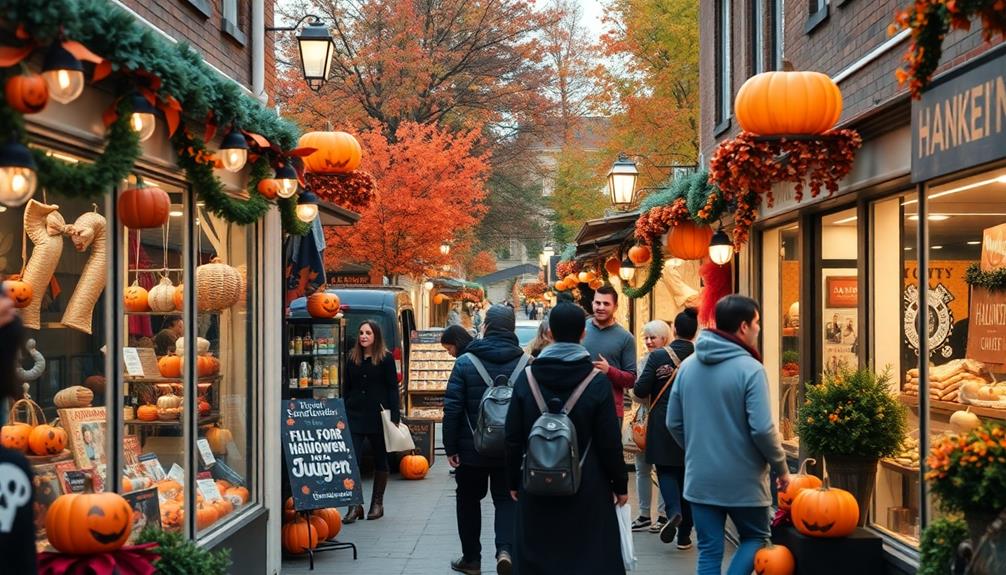
With 73% of consumers enthusiastic to engage in Halloween festivities this year, businesses are seizing the opportunity to boost their marketing efforts. The recent surge in engagement can also be likened to the excitement surrounding celebrity events, such as the recent Met Gala extravaganza, showcasing how themed activities can create buzz.
To maximize Halloween spending, local businesses are implementing innovative marketing strategies that foster customer engagement. Here are a few effective tactics:
- Themed Events: Hosting costume contests or pumpkin carving competitions can draw crowds and create buzz.
- Joint Promotions: Collaborating with neighboring stores for bundled discounts enhances visibility and attracts foot traffic.
- Social Media Campaigns: Leveraging Halloween themes in your online presence can greatly increase interactions and shares among consumers.
These strategies not only enhance customer experiences but also stimulate economic activity within the community.
As local businesses ramp up their efforts, they can expect to benefit from the projected $12.2 billion in Halloween spending for 2023. Events and promotions create excitement and draw in customers, turning your business into a go-to destination for Halloween goodies.
Plus, the media exposure from these festivities can provide invaluable publicity, making your city a more attractive spot for tourists. By embracing these marketing strategies, you can carve out a larger slice of the Halloween economy this season.
Challenges Faced by Local Businesses

Halloween can be a double-edged sword for businesses looking to capitalize on the festive season. While it presents opportunities, it also brings significant challenges. Increased competition among local retailers can diminish profitability. With many businesses offering similar products and promotions, standing out becomes tough.
Additionally, safety concerns related to Halloween events, like haunted houses and parades, may deter community participation, limiting potential revenue. It's important for businesses to take into account wood stove safety standards when planning events that involve fire or heat sources, as any safety oversight could lead to reduced attendance if people feel unsafe. If people feel unsafe, they're less likely to engage, directly impacting your bottom line.
Economic downturns can further complicate matters; shifts in consumer spending habits often mean fewer dollars spent on Halloween festivities, hitting businesses that depend on seasonal sales.
Additionally, environmental concerns are on the rise. Many consumers are now more eco-conscious, and businesses may struggle to balance festive offerings with sustainable practices. Waste from decorations and costumes can pose a dilemma.
Long-term Economic Effects of Halloween
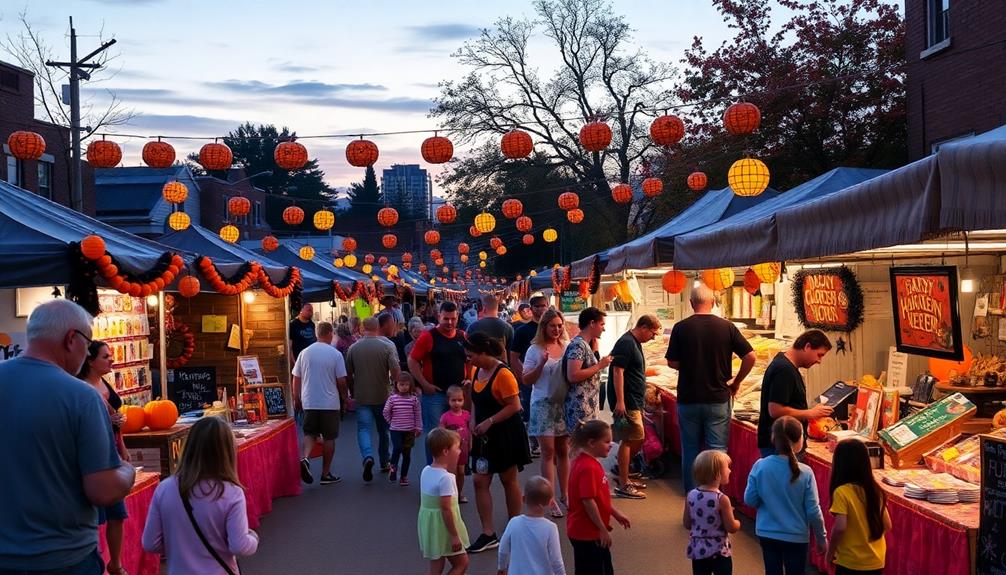
As the festive season wraps up, businesses often find that Halloween's economic impact lingers well beyond October. Retailers analyze spending on Halloween to adapt their strategies throughout the year, enhancing overall sales. This holiday not only boosts immediate profits but also influences long-term growth in local economies.
- Urban areas see increased participation in Halloween festivals, leading to sustained economic activity.
- Seasonal job creation provides part-time workers with opportunities that can evolve into permanent roles in retail and hospitality sectors.
- The heightened visibility from Halloween events attracts tourists year-round, further enhancing economic stability.
The ripple effects of Halloween reach far beyond direct sales. Analysts view Halloween spending as a barometer for consumer confidence, reflecting the broader economic landscape. This insight can guide investment decisions in related industries, ensuring that businesses remain responsive to changing market dynamics.
Ultimately, the long-term economic effects of Halloween can foster community resilience and growth, making it a vital element for local economies. By capitalizing on this festive season, you can contribute to a thriving environment that benefits everyone involved.
Frequently Asked Questions
What Impact Does Halloween Have on the Economy?
Halloween's impact on the economy's significant; you see increased consumer spending, tourism boosts, and seasonal job creation. It drives sales in retail and hospitality, fostering community spirit, and enhancing local pride through festive events.
What Industries Are Most Affected by Halloween?
You'll see Halloween greatly affects the retail, tourism, and e-commerce industries. Costume shops, haunted attractions, and online sales all thrive, while local artisans benefit from increased demand for unique decorations and costumes.
What Is Halloween the Second Largest Consumer Holiday in the USA Only Surpassed By?
Halloween's projected spending of $12.2 billion in 2023 shows its significance. It's the second largest consumer holiday in the USA, only surpassed by Christmas, highlighting its major role in American culture and economy.
Is Halloween the Most Commercially Successful Holiday?
No, Halloween isn't the most commercially successful holiday. Christmas outpaces it considerably. However, Halloween still generates impressive consumer spending and influences various sectors, showcasing its strong economic presence within the holiday landscape.
Conclusion
In the end, Halloween's impact on local economies goes far beyond just retail sales. You'll find that haunted houses and pumpkin patches draw tourists, while seasonal businesses thrive, creating jobs and community engagement. Coincidentally, as you enjoy a spooky night out, you're also supporting your local economy. So, next time you're donning a costume or munching on candy, remember that your fun fuels growth and connection in your community. Halloween truly brings everyone together!
Hello, I’m Damien, the editor-in-chief here at Halloween Product Reviews. As a lover of all things Halloween, my goal is to be your one-stop resource. Whether you’re seeking costumes, decorations, or just looking to embrace the festive spirit, our expert team is here to assist in making your Halloween truly spectacular. My personal joy comes from dressing up, decorating my home, and diving into the Halloween festivities. I’m here to help make your Halloween as spooky and fun as possible!
Halloween
How to Create a Halloween-Themed Podcast: Tips for Spooky Storytelling
How can haunting tales and spine-chilling sound effects transform your podcast into a Halloween sensation? Discover the secrets for spine-tingling storytelling!

Creating a Halloween-themed podcast is a thrilling adventure! Start by picking a catchy title that reflects your spooky vibe. Plan your episodes with strong narratives, incorporating eerie sound effects and engaging guest stories. Use vivid imagery and suspenseful scripting to draw listeners in. Don't forget to design eye-catching visuals that capture the Halloween spirit. Promote your podcast through social media and contests, inviting your audience to share their own spooky tales. With these tips, you'll create an unforgettable experience that thrills every listener. Stick around to uncover more tricks and treats for your eerie journey!
Key Takeaways
- Choose a compelling and unique podcast title that captures the Halloween theme and resonates with your target audience.
- Craft suspenseful narratives using strong imagery, real-life experiences, and folklore to create an engaging storytelling atmosphere.
- Incorporate audio enhancements like Halloween-themed music and sound effects to build suspense and enhance listener immersion.
- Utilize social media for promotion, engaging followers with polls, contests, and opportunities to share their spooky stories.
- Maintain consistent visual branding across all materials, using a color palette and imagery that evoke the Halloween spirit.
Podcast Title Ideas
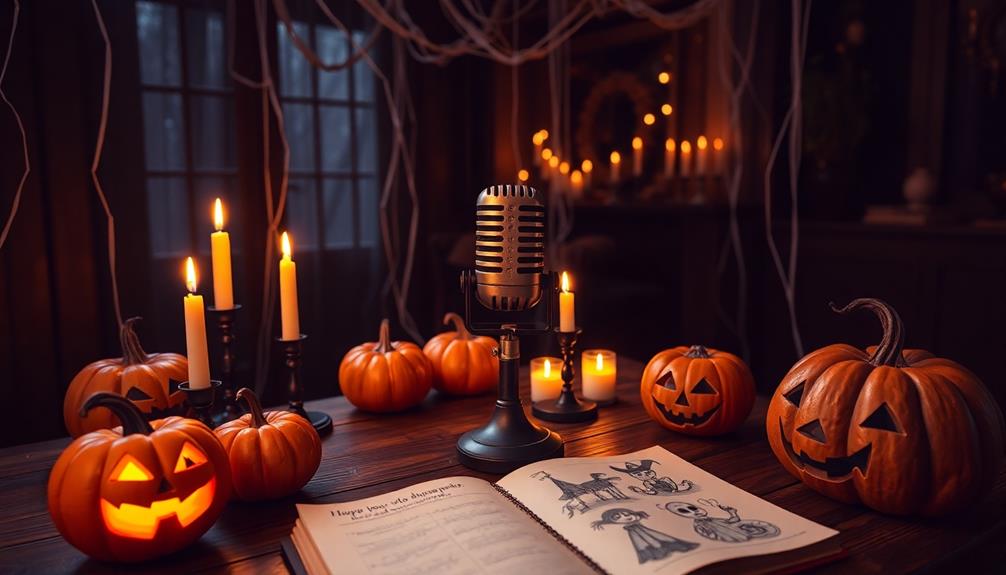
When brainstorming podcast title ideas, consider incorporating puns or clever wordplay to create a sense of fun and intrigue. A catchy title can make your Halloween podcast stand out in an ever-growing sea of options.
Think about titles like "The Haunted Hour" or "The Monster Mash-Up." These not only evoke spooky themes but also spark curiosity among potential listeners. Exploring themes of minimalism and simplicity, much like the ethos of tiny homes, can also inspire unique storytelling angles that resonate with your audience.
For instance, you might consider titles that reflect the eerie charm of a small, secluded space, such as tiny house living.
Aim for concise and memorable titles that encapsulate your podcast's essence. Use Halloween imagery or references to attract those keen for seasonal content. For instance, titles like "Ghost Stories Released" or "Creepy Chronicles" can instantly signal the spooky storytelling you offer.
To guarantee your title resonates, do some research. Check out existing horror podcasts for inspiration, but make sure your title is unique.
Testing your ideas with friends or potential listeners can provide valuable feedback. Ask them what feelings or thoughts your title evokes, and adjust accordingly.
Audio Enhancements

Enhancing your podcast with audio elements can transform an ordinary episode into an immersive experience. Choosing the right Halloween-themed music for your intros and outros sets the spooky tone right from the start. Pair this with sound effects like howling winds, creaking doors, and distant screams to evoke a chilling atmosphere.
Utilize royalty-free music and sound effects to keep your audio enhancements legal while guaranteeing a high-quality listening experience. Remember to test your audio quality on various playback devices to assure clarity and impact.
To help you visualize your audio strategy, here's a quick reference table:
| Audio Element | Purpose | Tips |
|---|---|---|
| Halloween Music | Set the spooky atmosphere | Use for intros and outros |
| Sound Effects | Enhance storytelling | Layer strategically for tension |
| Royalty-Free Sources | Avoid copyright issues | Check platforms like Free Music Archive |
| Playback Testing | Ensure audio clarity | Test on headphones, speakers |
| Layering Techniques | Build suspense | Gradually increase intensity |
Visual Branding
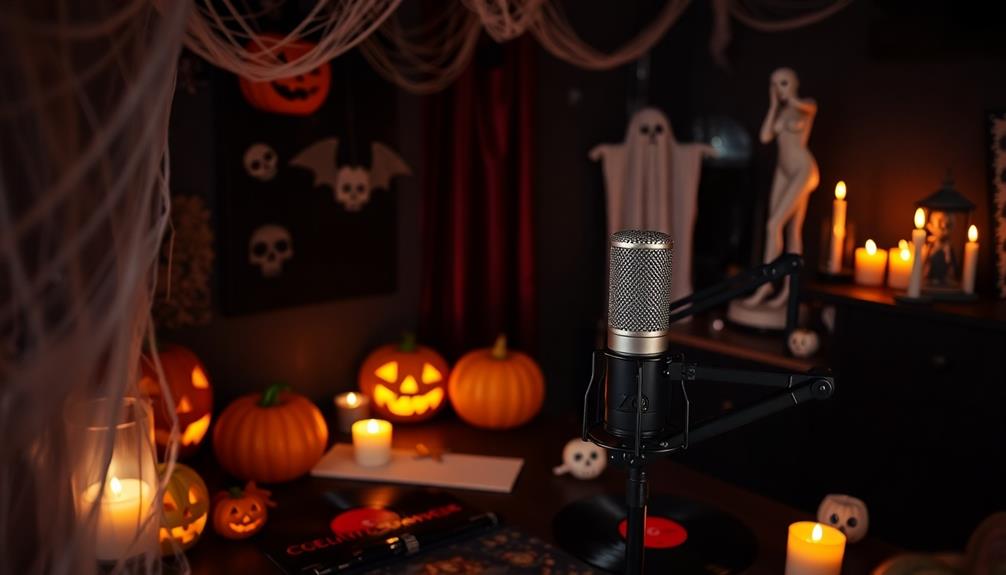
Audio enhancements set the mood for your Halloween-themed podcast, but visual branding is just as important for capturing attention.
Start by designing an enchanting podcast logo that features spooky imagery like ghosts or pumpkins. This creates an immediate connection to the Halloween theme. Use a color palette of orange, black, and purple across all banners and promotional materials to evoke that traditional Halloween atmosphere, drawing in potential listeners.
Consider incorporating elements from modern farmhouse decor, like rustic textures, to add warmth and charm to your visuals, making them more inviting.
Ensure that all visual branding elements, including social media graphics and website design, maintain a consistent spooky theme. This consistency boosts recognition and listener engagement.
Incorporate playful and eerie fonts to enhance your branding, making it perfect for the spooky season.
Don't forget to create eye-catching cover art that visually represents your podcast's theme and content. This artwork can greatly influence listener interest and engagement, prompting them to hit play.
Episode Planning
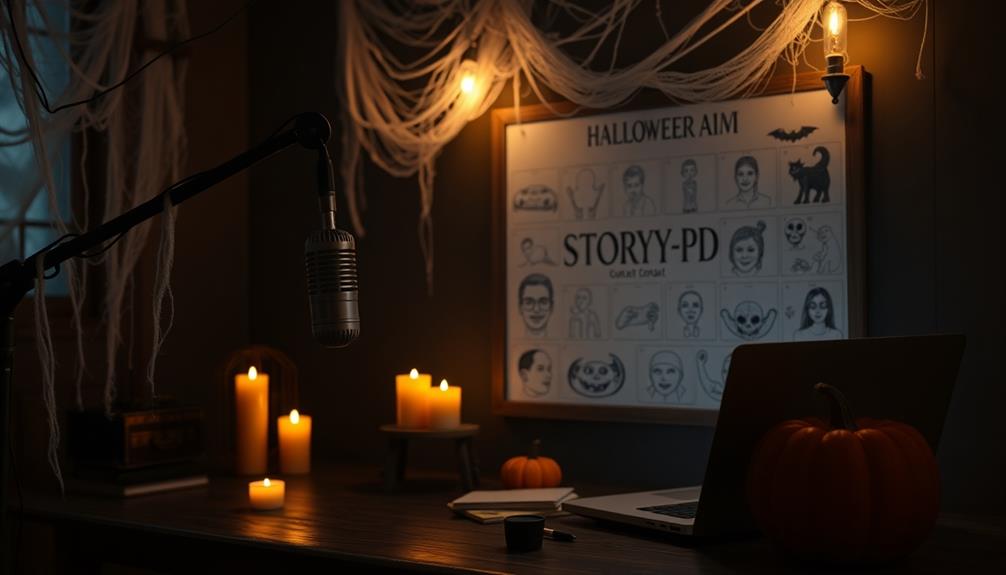
Crafting an enchanting Halloween-themed podcast requires thoughtful episode planning to keep your audience engaged. Start by developing a series of episodes that explore various Halloween themes, such as spooky folklore, urban legends, and Halloween traditions. This creates a cohesive narrative leading up to the holiday.
To enrich your content, consider including guest interviews with experts in horror literature or local ghost stories. Engaging your listeners can be achieved by incorporating polls or questions related to each episode's topic, encouraging them to share their thoughts and experiences.
Outline each episode with a clear introduction, body, and conclusion to guarantee coherent storytelling. Schedule your releases weekly or bi-weekly as Halloween approaches to build anticipation.
Here's a sample episode planning table:
| Episode Title | Theme | Guest/Activity |
|---|---|---|
| Spooky Folklore | Folklore Stories | Author Interview |
| Urban Legends | Local Myths | Paranormal Investigator |
| Halloween Traditions | Cultural Practices | Community Member Interview |
| Ghost Stories | Personal Experiences | Listener Story Sharing |
| Creepy Creatures | Mythical Beasts | Expert on Cryptozoology |
With this structure, you're setting the stage for an enthralling series!
Writing and Scripting
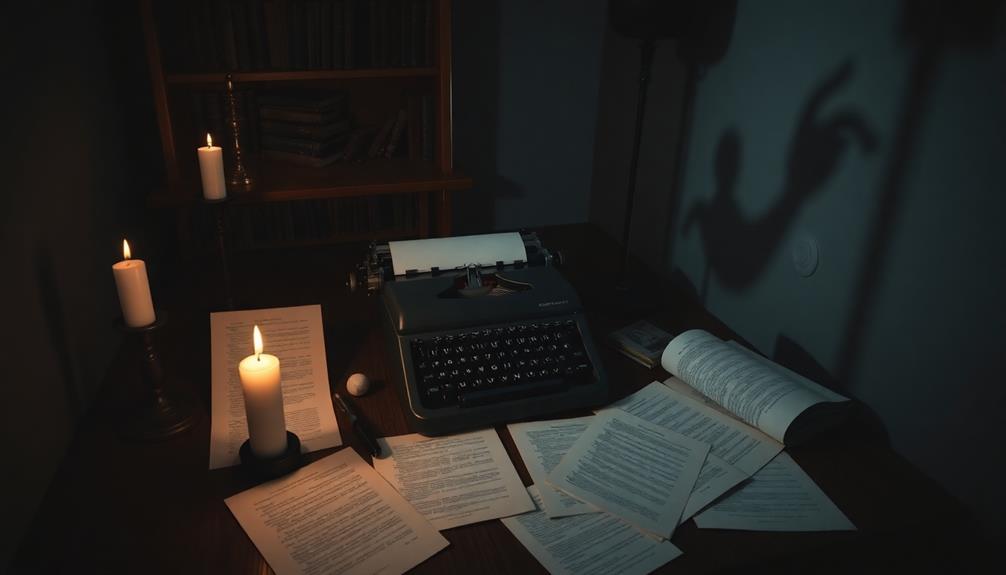
When you're writing for your Halloween-themed podcast, focus on crafting suspenseful narratives that keep your listeners on the edge of their seats.
Incorporating elements of astrological appeal can add an intriguing layer to your storytelling, as different zodiac signs may evoke unique characteristics in your characters.
Balance dialogue and narration to create a dynamic storytelling experience that feels immersive.
Crafting Suspenseful Narratives
As Halloween approaches, you'll want to immerse your listeners in spine-chilling tales that keep them on the edge of their seats. Start by employing strong imagery and sensory details in your scripts. Describe the rustling leaves, the creaking doors, and the chilling whispers to create an eerie atmosphere.
To enhance your storytelling further, consider incorporating techniques inspired by latest breakthroughs in machine learning tech that can help analyze audience engagement and preferences. Structure your narratives with a clear beginning, middle, and end. Use suspenseful cliffhangers to guarantee your audience is enthusiastic for the next episode.
Incorporating real-life experiences or folklore adds authenticity and depth, making your stories resonate more. Experiment with pacing; vary your sentence lengths, and don't shy away from strategic pauses. These techniques build tension and enhance emotional impact, making your listeners feel every moment.
Adding sound effects can amplify the mood—think how a sudden thunderclap or the distant howl of a wolf can send shivers down the spine.
Balancing Dialogue and Narration
To create an engaging Halloween-themed podcast, balancing dialogue and narration is vital for a rich storytelling experience. Your dialogue should reveal character emotions and motivations, while narration sets the scene and builds suspense. High-quality content can greatly enhance your podcast's credibility and keep listeners returning for more, which is essential for content quality and topical authority.
Here are some tips to help you strike that balance:
- Keep dialogue concise: Make it feel natural and authentic, so characters express themselves while keeping listeners hooked.
- Use descriptive narration: Evoke imagery and atmosphere with sensory details, immersing your audience in the spooky setting.
- Vary pacing: Fast-paced dialogue can ramp up tension, while slower narration builds suspense and anticipation.
- Focus on shifts: Confirm the transitions between dialogue and narration are seamless, enhancing storytelling rather than disrupting it.
- Edit for clarity: Review scripts to guarantee flow, allowing your narrative to unfold smoothly.
Promotion Strategies
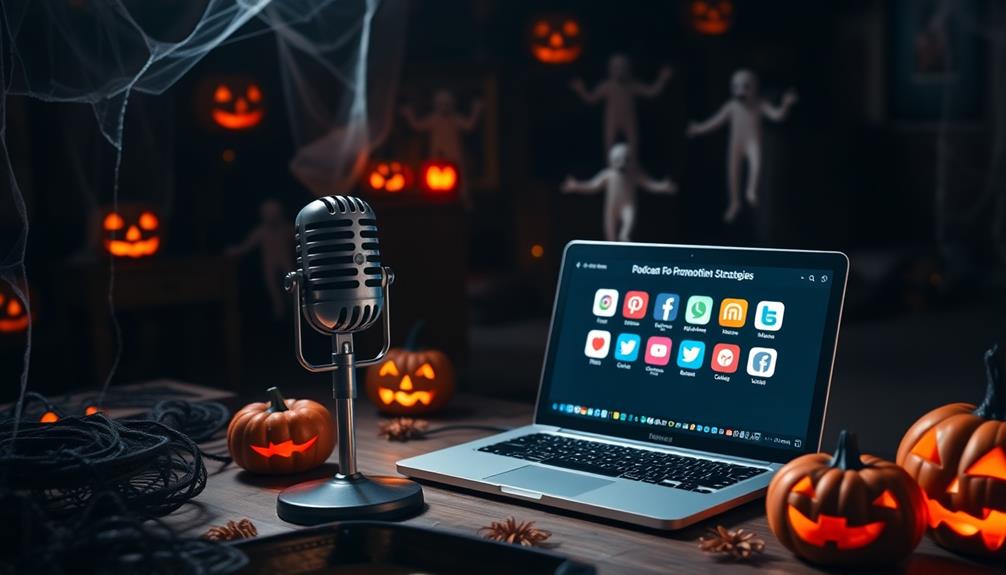
To boost your Halloween-themed podcast, focus on social media engagement and themed contests.
Incorporating unique elements like a DIY costume contest can enhance listener participation and excitement, similar to how themed breakfasts encourage community bonding.
Encourage your listeners to share their spooky stories or costume photos for a chance to win fun prizes.
This not only creates excitement but also expands your audience as participants spread the word.
Social Media Engagement
Effective social media engagement is essential for promoting your Halloween-themed podcast and attracting a wider audience. To make the most of this Halloween season, consider these strategies to enhance your online presence:
- Use Halloween-themed hashtags like #SpookySeason and #HalloweenPodcast to boost your visibility. Incorporating trending topics like Halloween costume ideas can also attract listeners who are interested in related themes.
- Share engaging visuals such as eye-catching cover art and themed graphics that resonate with Halloween motifs.
- Collaborate with other podcasters or Halloween-themed accounts for cross-promotion, tapping into their audiences.
- Regularly engage with followers by posting polls, asking questions, and responding to comments to create a sense of community.
- Host interactive contests where listeners can submit their own spooky stories or costume photos, encouraging them to share your content.
Themed Contests and Giveaways
Hosting themed contests and giveaways can greatly boost engagement for your Halloween-themed podcast while creating excitement among your audience.
Consider launching a Halloween-themed giveaway where listeners submit their favorite spooky stories inspired by the economic impact of local attractions during the Halloween season. The best entries could win themed prizes like candy-filled gift baskets or horror merchandise, enticing participation.
You can also encourage audience involvement by organizing a costume photo contest. Ask your followers to share their creative costumes on social media using a specific hashtag to enter for a chance to win exclusive podcast merchandise. This not only promotes engagement but also builds a sense of community.
To create urgency, implement time-sensitive contests such as a "Trick-or-Treat Challenge." Listeners must submit their entries by Halloween night to receive special treats, fostering excitement and participation.
Don't forget to utilize user-generated content! Feature selected listener stories or costume photos on your podcast, making participants feel valued and more connected to your show.
Engaging Your Audience

Engage your audience by inviting them to share their own spooky stories or Halloween experiences, creating a community feel around your podcast.
With Halloween celebrations varying globally, from Australia's growing popularity of trick-or-treating to Zambia's limited adoption of festivities, you can encourage listeners to share their unique cultural traditions related to Halloween Halloween celebrations around the world.
By encouraging participation, you're not just engaging your audience; you're building a vibrant community of listeners enthusiastic to connect.
- Ask listeners to submit their tales for a chance to be featured in an episode.
- Use social media polls and Halloween-themed questions to spark conversation.
- Create interactive segments, like live Q&As or Halloween trivia, to deepen audience investment.
- Promote contests or giveaways centered around Halloween to boost interaction and sharing.
- Share behind-the-scenes content or sneak peeks to maintain excitement throughout the season.
Frequently Asked Questions
How to Create a Storytelling Podcast?
To create a storytelling podcast, you'll want to establish a clear narrative structure, use vivid descriptions, incorporate suspense, and experiment with various techniques. Don't forget to seek listener feedback to fine-tune your approach!
What Do You Talk About on a Halloween Podcast?
On a Halloween podcast, you'll plunge into spooky folklore, urban legends, and ghost stories. You'll also review Halloween movies, explore haunted attractions, and share delicious recipes, creating an engaging experience for listeners craving the season's thrills.
What Is the Podcast About the Origins of Halloween?
Your podcast explores Halloween's origins, tracing back to the Celtic festival of Samhain. You investigate traditions like costumes and bonfires, revealing how these customs evolved into the modern celebration we understand today.
Conclusion
As you conjure up your Halloween-themed podcast, remember that each story is a thread in a spooky tapestry. With creative planning, engaging scripts, and haunting audio enhancements, you'll weave an unforgettable experience for your listeners. Don't forget to promote your eerie tales and engage your audience, turning casual listeners into devoted fans. So grab your microphone, let your imagination run wild, and invite everyone to join you on this chilling adventure—because the night is dark and full of stories waiting to be told!
Hello, I’m Damien, the editor-in-chief here at Halloween Product Reviews. As a lover of all things Halloween, my goal is to be your one-stop resource. Whether you’re seeking costumes, decorations, or just looking to embrace the festive spirit, our expert team is here to assist in making your Halloween truly spectacular. My personal joy comes from dressing up, decorating my home, and diving into the Halloween festivities. I’m here to help make your Halloween as spooky and fun as possible!
Halloween
You Can Wear Halloween Contacts With Astigmatism
Get ready to rock Halloween with astigmatism-friendly contacts, ensuring clear vision and spooky style – find out the best options ahead!
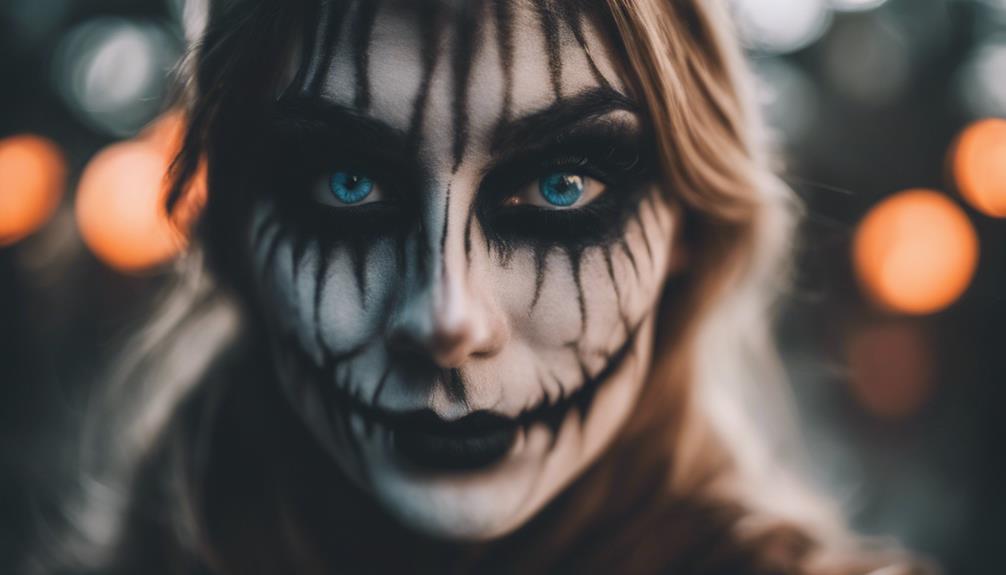
Yes, you can wear Halloween contacts even with astigmatism! Consider toric contact lenses, specially designed to correct astigmatism. Halloween contacts for astigmatism, while slightly pricier, merge style with clear vision. Optometrist consultation guarantees the right choice. These colored toric lenses not only enhance costumes but also meet your vision needs. Remember, comfort is key, quality matters, and proper care is vital for enjoyable wear. When selecting Halloween contacts with astigmatism, prioritize vision correction alongside style for a spooktacular look. More insights on choosing the best Halloween contacts await.
Key Takeaways
- Halloween contacts for astigmatism offer vision correction and style.
- Colored toric lenses are FDA approved and safe with a prescription.
- Custom-made toric lenses provide clear vision and a pop of color.
- Consult an optometrist for proper selection of astigmatism-friendly contacts.
- Quality toric lenses ensure comfort and accurate vision correction.
Overview of Astigmatism and Halloween Contacts
Understanding astigmatism is essential when considering Halloween contacts, especially for those needing vision correction. Astigmatism, characterized by an irregular corneal shape, requires specific lenses for correction.
For individuals with astigmatism looking to sport Halloween contacts, toric contact lenses are the go-to option. These specialized lenses are designed to address the unique needs of astigmatism, guaranteeing proper vision correction while still allowing for the fun of colored contacts for astigmatism.
While the variety of colored contacts for astigmatism may be limited compared to clear options, they still provide viable choices for Halloween enthusiasts. It's noteworthy that Halloween contacts for astigmatism may come at a slightly higher cost than regular ones due to the need for specialized lenses.
Consulting with an optometrist is essential to ensure that the Halloween contacts chosen effectively address astigmatism and provide the necessary vision correction for a safe and enjoyable Halloween experience.
Benefits of Halloween Contacts for Astigmatism
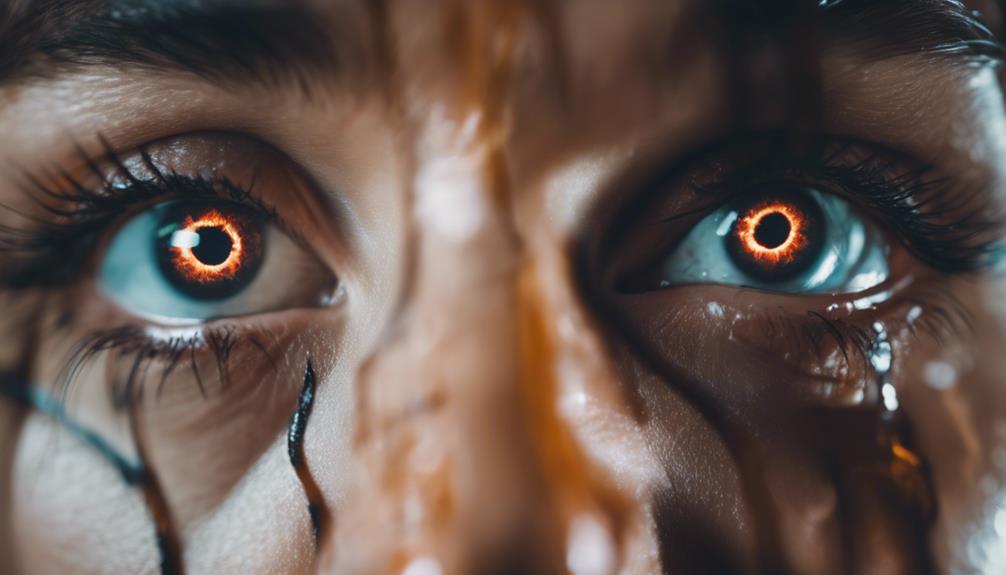
Halloween contacts for astigmatism provide you with lens options specifically tailored to your needs, ensuring both clear vision and a touch of spooky style.
With these specialty lenses, you can enhance your Halloween costume while maintaining comfortable and reliable vision throughout the night.
Rest assured that colored toric lenses are FDA approved, safe to use with a proper prescription, and offer a seamless blend of creativity and practicality for your Halloween festivities.
Astigmatism-Friendly Lens Options
When considering Halloween contacts for astigmatism, exploring astigmatism-friendly lens options can provide both vision correction and a touch of style. Colored toric lenses specifically designed for astigmatism offer a unique combination of vision correction and eye color modification. Custom-made toric lenses are tailored to address the irregular corneal shape characteristic of astigmatism, ensuring both clear vision and comfort.
These astigmatism-friendly colored contacts not only correct your vision but also enhance your natural beauty with a pop of color. Toric color contacts are crafted to provide stability and comfort, making them ideal for individuals with astigmatism who want to incorporate style into their vision correction routine.
The availability of colored toric lenses opens up a world of personalized and stylish options for those seeking both functional vision correction and a fun, fashionable twist. So, when choosing Halloween contacts for astigmatism, consider these astigmatism-friendly lens options to elevate your look while ensuring clear and comfortable vision.
Enhanced Spooky Costume
To enhance your spooky costume this Halloween, consider the benefits of opting for Halloween contacts designed for astigmatism. Colored contacts for astigmatism not only provide vision correction but also add an extra flair to your Halloween outfit. These special lenses offer a unique look that can elevate characters like zombies and vampires, making your costume stand out even more. By wearing Halloween contacts with astigmatism, you can enjoy both visual impact and comfort throughout the night, ensuring you look and feel your best while trick-or-treating or attending parties.
| Benefits of Colored Contacts for Astigmatism |
|---|
| Offers vision correction |
| Enhances your Halloween costume |
| Provides a unique look for spooky characters |
Clear Vision Assurance
Experience enhanced visual clarity and assurance with Halloween contacts designed for astigmatism. These specialized contact lenses not only offer a wide range of colored contact lens options to match your Halloween costume but also provide essential vision care for those with astigmatism.
By incorporating special prism ballast technology, these lenses guarantee a proper fit and orientation on your eyes, allowing you to enjoy a spooky look without compromising on visual acuity. FDA approved for safety and efficacy, Halloween contacts for astigmatism enable you to partake in the festive spirit with clear vision and confidence.
Whether you choose a vibrant hue to complement your outfit or a more subtle enhancement, these contact lenses for astigmatism cater to both your aesthetic preferences and your vision needs. Embrace the fun of Halloween without worrying about blurry vision, and revel in the excitement knowing that your eyes are taken care of with these specialized lenses.
Types of Halloween Contacts for Astigmatism
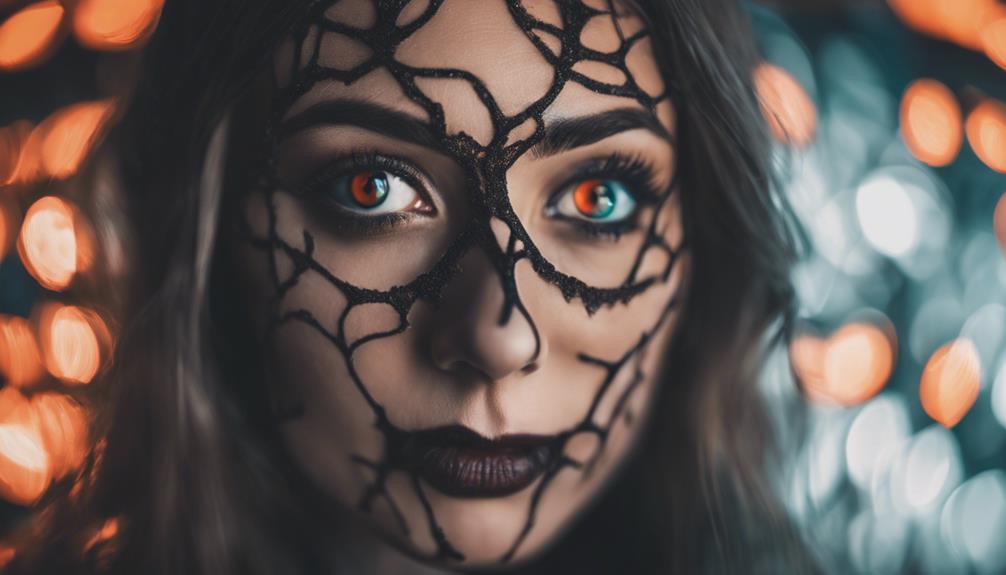
When looking for Halloween contacts for astigmatism, consider toric lenses specially crafted to correct your vision while adding a spooky touch to your costume. These lenses come in a variety of colors to suit your Halloween look.
Additionally, custom-made toric options allow you to choose the perfect color for your Halloween ensemble.
Toric Lenses for Astigmatism
Toric lenses tailored for astigmatism offer a specialized solution for individuals seeking Halloween contacts that provide both vision correction and a touch of color. Colored toric lenses cater to those with astigmatism, addressing the irregular corneal shape that standard lenses may not correct.
While there are colored options available, they might be more limited compared to clear toric lenses. Some manufacturers do offer exclusive colored toric lenses for astigmatism, but these can come with a higher price tag. It's important to note that regular soft colored contacts may not be suitable for astigmatism correction, making toric lenses the preferred choice.
When considering colored toric lenses, the cylinder number in your prescription plays a significant role in determining the available options. By opting for these specialized lenses, you can enjoy both corrected vision and a fun color choice for your Halloween look.
Custom-Made Options Available
Custom-made Halloween contacts for astigmatism offer a personalized solution for individuals looking to blend vision correction with festive colors and styles. These custom-made toric lenses cater to those with astigmatism, ensuring both clear vision and a spooky look for Halloween.
Here are some key points when opting for custom toric lenses:
- Custom-made toric contact lenses are specifically designed for individuals with astigmatism who wish to wear Halloween-themed contacts.
- These lenses not only correct astigmatism but also come in various colors and styles perfect for the Halloween season.
- Production of custom toric Halloween contacts may take 1-2 weeks based on the individual's prescription requirements.
- For individuals needing their custom lenses sooner for special events, express shipping options are available.
- Custom toric lenses provide the dual benefit of vision correction for astigmatism and the fun of colored contacts for enhancing Halloween costumes.
How to Choose Halloween Contacts With Astigmatism
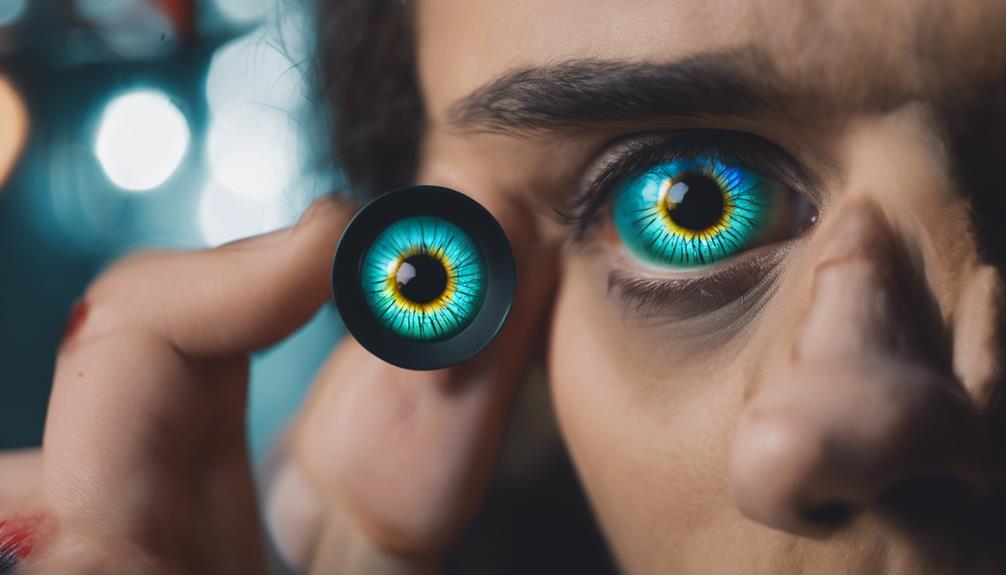
To select the perfect Halloween contacts for astigmatism, consider the cylinder number in your prescription as it impacts the available colored lens options.
For astigmatism, you need toric lenses that correct the irregular curvature of the eye. Some manufacturers offer colored toric lenses specifically designed for astigmatism, providing both vision correction and the fun of colored contacts for Halloween.
The cylinder number in your prescription will determine the colored lens options available to you. While ordinary soft colored contacts may work for low levels of astigmatism, it's best to consult with an optometrist to make sure you get the right fit.
Keep in mind that colored toric lenses might be slightly more expensive than clear ones, but they offer the benefit of correcting your vision while adding a pop of color for your Halloween look.
Tips for Wearing Halloween Contacts Safely With Astigmatism

When wearing Halloween contacts with astigmatism, prioritize safety by following proper lens care and hygiene practices. To guarantee a comfortable and risk-free experience, consider the following tips:
- Consult with an optometrist: Before trying colored contacts for astigmatism, seek professional advice to get the right type of toric lenses for your eyes.
- Opt for toric lenses: Choose Halloween contacts specifically designed for astigmatism to maintain clear vision and prevent discomfort.
- Limit options with colored toric lenses: Understand that colored toric lenses for astigmatism may have fewer choices compared to clear toric lenses.
- Practice good lens care: Keep your Halloween contacts clean and disinfected to avoid eye infections or irritation.
- Consider severity: The severity of your astigmatism can impact the availability and suitability of colored toric lenses, so keep this in mind when selecting your lenses.
Popular Halloween Contact Lens Styles for Astigmatism
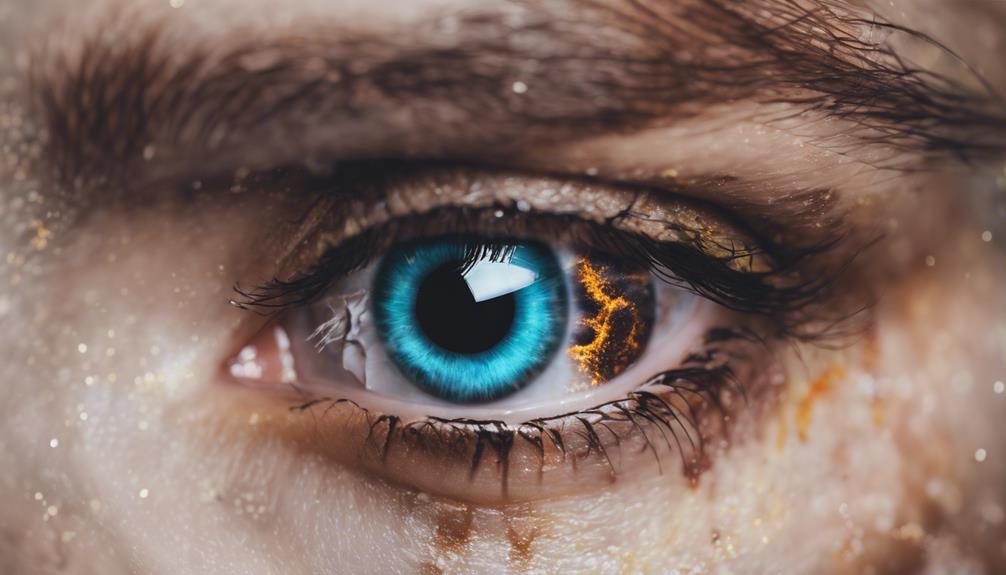
For Halloween enthusiasts with astigmatism, exploring popular contact lens styles opens up a world of spooky and dramatic costume possibilities. When it comes to Halloween contact lens styles designed specifically for astigmatism, toric lenses with prism ballast technology provide excellent vision correction while adding a touch of flair to your costume.
Colored toric lenses are perfect for classic cat eyes or reptile-themed outfits, allowing you to fully embody your character. If you're aiming for a spooky look like a zombie, lenses with bloodshot or white eyes can enhance the effect. Vampire fans can choose from a variety of colored contacts to match their favorite vampire characters, adding an authentic touch to their costume.
For a quick animal transformation effect, werewolf lenses in striking colors like green or orange are a popular choice. With these Halloween contact lens styles tailored for astigmatism, you can embrace the spirit of the season with confidence and style.
Where to Buy Halloween Contacts for Astigmatism

If you're in search of Halloween contacts for astigmatism, consider looking for specialized retailers that offer colored toric lenses designed specifically for individuals with this eye condition. Some manufacturers create colored toric lenses exclusively for individuals with astigmatism. The cost of colored toric lenses for Halloween may be higher compared to clear toric lenses, so budgeting accordingly is crucial.
Depending on the level of astigmatism, regular soft colored contacts may work for some individuals, providing more options available for those looking to enhance their Halloween costume with colored lenses. Remember that the cylinder number in the prescription plays a crucial role in determining the colored contact lens options available for astigmatism.
- Specialized retailers offer colored toric lenses for astigmatism.
- Some manufacturers create colored toric lenses exclusively for individuals with astigmatism.
- Cost of colored toric lenses for Halloween may be higher than clear toric lenses.
- Regular soft colored contacts may work for some individuals with astigmatism.
- The cylinder number in the prescription influences the colored contact lens options available for astigmatism.
Halloween Contact Lens Care for Astigmatism
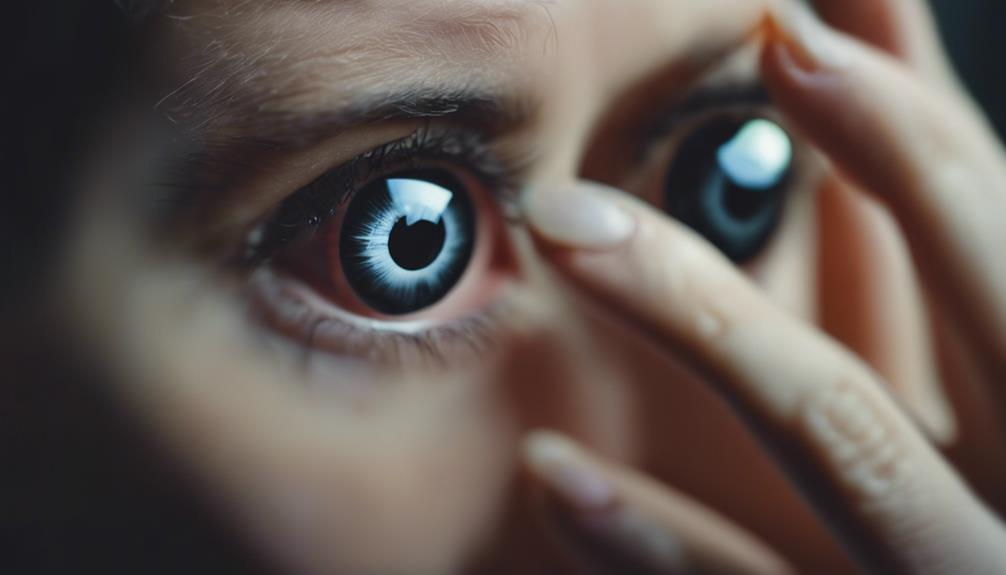
Proper care of Halloween contact lenses for astigmatism involves soaking them in solution for a minimum of 8 hours. Taking care of your lenses is important for maintaining good eye health, especially when dealing with astigmatism. Follow the recommended cleaning and storage instructions to guarantee your eyes stay comfortable and healthy. Remember not to wear your Halloween contact lenses for too long to avoid discomfort and potential eye issues. If you experience any eye irritation, it's best to seek professional advice promptly. Ensuring proper care for your lenses is essential to prevent complications or discomfort related to astigmatism.
| Care Tips for Halloween Contact Lenses with Astigmatism | |||
|---|---|---|---|
| 1. Soak lenses for at least 8 hours | 2. Follow cleaning instructions | 3. Avoid wearing lenses for extended periods | 4. Seek professional advice for eye irritation |
Astigmatism Prescription Requirements for Halloween Contacts
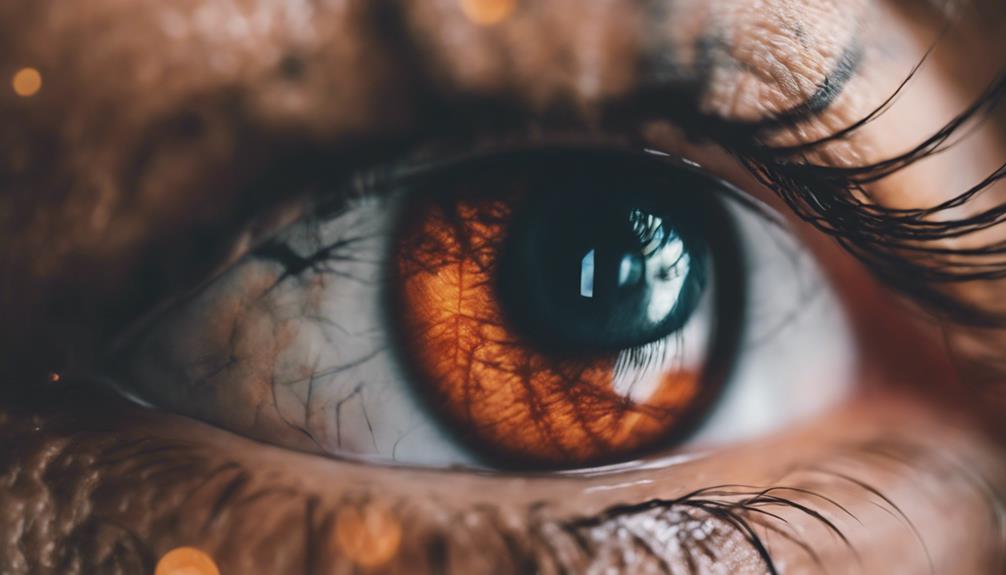
When searching for Halloween contacts for astigmatism, it's crucial to bear in mind that they necessitate a specific toric prescription tailored to your unique eye shape. This prescription includes details like spherical power, astigmatism power, and axis to guarantee proper vision correction.
Without the correct astigmatism prescription, Halloween contacts may not offer the necessary vision correction for your eyes.
Astigmatism and Contact Lenses
When selecting Halloween contacts for astigmatism, your eye care professional will prescribe toric lenses with specific measurements to guarantee proper vision correction. Toric lenses are specially designed for astigmatism, as they've different powers in various meridians to address the irregular corneal shape.
For Halloween contacts catering to astigmatism, it's important that details like cylinder, axis, and sphere measurements are accurately prescribed. This ensures that the contacts correct your vision effectively while providing a comfortable fit. The prescription requirements for Halloween contacts with astigmatism include specific details such as cylinder power and axis angle.
Consulting an eye care professional is vital to ensure the correct prescription and fitting of Halloween contacts for astigmatism. Remember, accurate measurements and a proper fit are key to enjoying Halloween with clear and comfortable vision.
- Toric lenses are designed with different powers in different meridians.
- Specific measurements like cylinder, axis, and sphere are important for Halloween contacts with astigmatism.
- Prescription requirements for Halloween contacts include cylinder power and axis angle.
- Consulting an eye care professional ensures correct prescription and fitting.
- Accurate measurements and a proper fit are essential for clear and comfortable vision.
Finding Suitable Halloween Contacts
Guarantee precise vision correction for astigmatism by selecting Halloween contacts that meet specific prescription requirements, including spherical, astigmatism, and axis measurements. For individuals with astigmatism, toric lenses are crucial to accurately correct vision. These specialized lenses are designed to address the irregular corneal shape characteristic of astigmatism, ensuring clear and comfortable vision.
When searching for Halloween contacts, make sure to provide your eye care professional with your astigmatism prescription details to guarantee the lenses are tailored to your specific needs. Custom-made toric color contacts are available, offering a variety of color options to match your desired look while still providing the necessary astigmatism correction.
Keep in mind that ordering custom toric lenses may require a wait time of 1-2 weeks on average, so plan ahead to have your Halloween contacts ready for the spooky season. With colored toric lenses, you can enjoy both a vibrant appearance and accurate vision correction for a fantastic Halloween celebration.
Final Thoughts on Wearing Halloween Contacts With Astigmatism
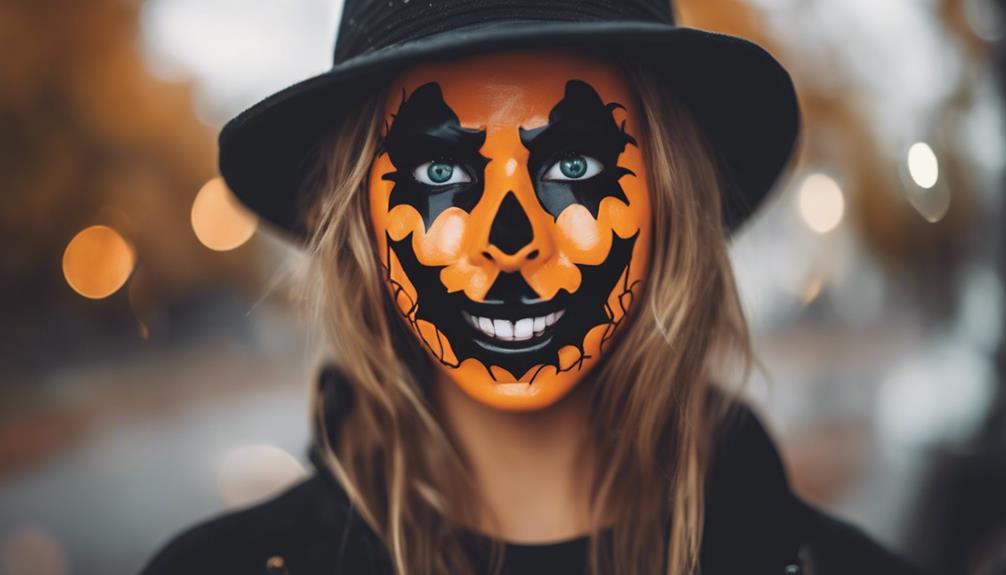
In considering Halloween contacts for astigmatism, remember the importance of both enhancing your costume and correcting your vision.
When it comes to wearing Halloween contacts with astigmatism, there are some final thoughts to keep in mind:
- Comfort is Key: Guarantee the toric color contacts are comfortable to wear for extended periods.
- Vision Correction Matters: Don't compromise vision correction for style; choose contacts that cater to your astigmatism.
- Quality over Price: Invest in high-quality toric lenses to prevent any discomfort or vision issues.
- Follow Proper Care Instructions: Maintain the contacts properly to avoid any eye infections or discomfort.
- Consult an Eye Care Professional: Before trying any new contacts, consult your eye doctor to ensure they're suitable for your eyes.
Frequently Asked Questions
Can I Wear Non-Prescription Contacts With Astigmatism?
You can't wear non-prescription contacts with astigmatism. Astigmatism requires special toric lenses for proper vision correction. Using non-prescription contacts can cause discomfort and blurred vision.
It's important to consult with an optometrist to find the best contact lens options for your astigmatism. Non-prescription contacts won't address the irregular corneal shape in astigmatism, affecting your vision quality. Stick to toric lenses recommended by your eye care professional for the best vision correction.
Why Can't I Get Colored Contacts for Astigmatism?
When it comes to colored contacts for astigmatism, regular ones won't do the trick. Astigmatism requires special toric lenses to correct that irregular corneal shape.
The unique design of colored toric lenses can be pricier due to this specialized need. Unlike non-astigmatism colored contacts, these ones cater to your specific vision needs.
Can You Wear Night Contacts With Astigmatism?
Yes, you can wear night contacts with astigmatism. These special lenses, also known as ortho-k or CRT lenses, are worn while you sleep to reshape your cornea and improve your vision during the day.
They offer a non-surgical way to correct astigmatism temporarily, providing clear vision without glasses or regular contacts.
Consult with an eye care professional to determine if night contacts are a suitable option for your astigmatism.
What Are the Best Contacts for a Bad Astigmatism?
When dealing with a bad astigmatism, toric contact lenses are your go-to choice. Their specialized design caters to irregular corneal shapes, ensuring proper vision correction.
Especially for higher astigmatism levels, around + or – 2.00, getting the right fit with toric lenses is essential. Opting for custom-made toric color contacts can't only address severe astigmatism but also add a touch of style with various color options.
Consult your optometrist to guarantee the perfect prescription for your bad astigmatism needs.
Conclusion
To sum up, wearing Halloween contacts with astigmatism is possible with the right type of lenses and proper care. Remember the saying, 'Better safe than sorry,' when it comes to your eye health.
Be sure to consult with your eye doctor, choose the correct prescription, and follow all recommended guidelines for wearing and caring for your Halloween contacts.
With these precautions in mind, you can enjoy a spooky and safe Halloween with your unique and stylish lenses.
Hello, I’m Damien, the editor-in-chief here at Halloween Product Reviews. As a lover of all things Halloween, my goal is to be your one-stop resource. Whether you’re seeking costumes, decorations, or just looking to embrace the festive spirit, our expert team is here to assist in making your Halloween truly spectacular. My personal joy comes from dressing up, decorating my home, and diving into the Halloween festivities. I’m here to help make your Halloween as spooky and fun as possible!
-

 Halloween3 months ago
Halloween3 months agoMga Tauhan ng Florante at Laura Costume
-

 Halloween3 months ago
Halloween3 months agoCan You Go to Halloween Horror Nights While Pregnant?
-

 Halloween3 months ago
Halloween3 months agoSexy Harry Potter Outfits For Halloween
-

 Halloween3 months ago
Halloween3 months agoA Child in a Hitler Costume Causes a Stir Online
-

 Halloween3 months ago
Halloween3 months agoAlvin and the Chipmunks Costume Ideas
-

 Halloween3 months ago
Halloween3 months agoHow to Get Halloween Cookies in Cookie Clicker
-

 Halloween3 months ago
Halloween3 months agoHow to Protect Halloween Animatronics From Rain
-

 Halloween3 months ago
Halloween3 months agoHow to Dress Up in a Rip and Beth Costume











